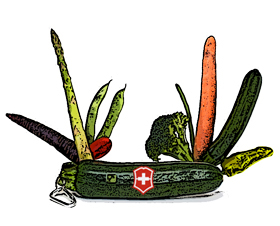The Salt Conundrum In Food & Wine Pairing.
Chapter Nine, Part Eight.
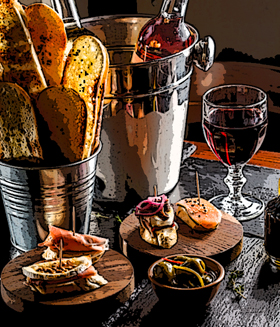 When pairing food with wine, sweet and sour tastes fall neatly into the cancellation category, bitter and piquant are subject to the cumulative effect, and umami is best grouped with neutral pairings, but what about salt? In moderation, salt doesn’t seem to have any conspicuous consequence, but how does excessive saltiness in food affect the taste of wine? To learn how (or if) salt fits into the A. cancellation, B. cumulative or C. neutral categories, I invited some friends over for some organoleptic research. They quickly declined until I told them that meant we were going to eat and drink wine.
When pairing food with wine, sweet and sour tastes fall neatly into the cancellation category, bitter and piquant are subject to the cumulative effect, and umami is best grouped with neutral pairings, but what about salt? In moderation, salt doesn’t seem to have any conspicuous consequence, but how does excessive saltiness in food affect the taste of wine? To learn how (or if) salt fits into the A. cancellation, B. cumulative or C. neutral categories, I invited some friends over for some organoleptic research. They quickly declined until I told them that meant we were going to eat and drink wine.
Good old fashioned research is difficult and time consuming but in the name of conscientious reporting the WASTED team (Wine Snark Academy for Sensory Testing, Evaluation & Debauchery) created a salty feast and drank five bottles of wine because that’s the kind sacrifice we’re willing to make in the name of, umm … science, yeah that’s it, science.
Read MoreThe Neutral Effect In Food and Wine Pairing.
The impact of the chemical reactions taking place in your mouth when you combine food and wine can be very obvious when you’re experiencing the cancellation effect or the cumulative effect, but there’s another interaction between food and wine that’s just as rewarding, but much less pronounced. I call this subtle interplay the neutral effect. I realize that describing a food and wine pairing as neutral sounds sort of, well … neutral, but that doesn’t mean these combinations are boring. Neutral pairings occur when similar flavors come together in a safe, reassuring place, sort of like Switzerland.
Read MoreThe Cumulative Effect In Food And Wine Pairing.
Chapter Nine, Part Six.
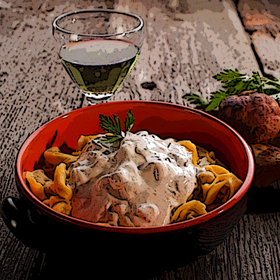 When pairing food with wine the cancellation effect works to your advantage once you understand how to balance the taste or texture of sweet and acidic food with similar traits in wine. While acidity and sweetness cancel each other out when combined on your palate, bitter and piquant sensations accumulate and magnify one another. The same can be said for pairing low acid foods with low acid wines so I’ll go ahead and say it; creamy or fatty traits do not cancel each other out; they accumulate on your palate (and also on your waistline). So after many years of deliberation I’ve decided to call this the cumulative effect.
When pairing food with wine the cancellation effect works to your advantage once you understand how to balance the taste or texture of sweet and acidic food with similar traits in wine. While acidity and sweetness cancel each other out when combined on your palate, bitter and piquant sensations accumulate and magnify one another. The same can be said for pairing low acid foods with low acid wines so I’ll go ahead and say it; creamy or fatty traits do not cancel each other out; they accumulate on your palate (and also on your waistline). So after many years of deliberation I’ve decided to call this the cumulative effect.
In Search Of Umami.
Chapter Eight, Parts One & Two.
Where Have You Been All My Life?
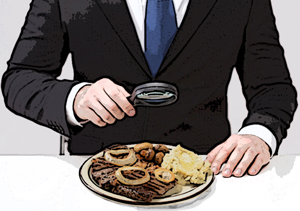 Sweet, sour, salt, bitter … sweet, sour, salt, bitter. I repeated those words at so many events for so many years that the phrase was like my own personal mantra, rooted in my psyche by daily visits to the Deli Lama. Just imagine my concern when I learned of umami – the existence of a fifth taste was surely going to throw off my mantra rhythm. Sweet, sour, salt, bitter … UMAMI? It has a good beet but you just can’t trance to it.
Sweet, sour, salt, bitter … sweet, sour, salt, bitter. I repeated those words at so many events for so many years that the phrase was like my own personal mantra, rooted in my psyche by daily visits to the Deli Lama. Just imagine my concern when I learned of umami – the existence of a fifth taste was surely going to throw off my mantra rhythm. Sweet, sour, salt, bitter … UMAMI? It has a good beet but you just can’t trance to it.
Not only did this secretive fifth taste exist, it existed right under my nose – where my mouth is conveniently located. I knew if I was ever going to get my mantra groove back I needed to embrace the mystical taste I’d overlooked for so long. I gathered articles and books on the subject and soon learned that describing the taste of umami is like describing the flavor of wine, it’s just so many words on a page. Umami, like wine, must be experienced to be understood.
Read MoreFlavor. Taste Is Only Half Of It.
Chapter Two, Part Six.
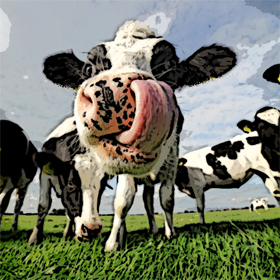 Have you ever wondered how your palate is capable of identifying so many different flavors in food and wine since your taste buds are limited to just five basic stimulants? If your taste buds are only capable of discerning sweet, sour, salt, bitter and umami, why are wine reviews so wordy and wine magazines so thick? (Yeah I know, it takes a lot of ads to earn 90 points).
Have you ever wondered how your palate is capable of identifying so many different flavors in food and wine since your taste buds are limited to just five basic stimulants? If your taste buds are only capable of discerning sweet, sour, salt, bitter and umami, why are wine reviews so wordy and wine magazines so thick? (Yeah I know, it takes a lot of ads to earn 90 points).
Your taste buds may be limited, but deciphering flavor employs much more than your sense of taste. It’s the synergistic work of olfaction and gustation that unite to interpret flavor. This phenomenon is commonly called gusfaction. I’m sorry but I can’t help myself, I like to combine big words because I don’t get paid by the word – I get paid by the punctuation mark (which is why I end every paragraph with parenthesis).
Read More

